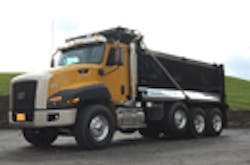EDWARDS, IL. Though Caterpillar’s new CT660 vocational truck seems in many ways to have appeared on the commercial vehicle scene as if from nowhere, it’s actually followed a long and winding development trail that stretches back to 2003 – back when the company started realizing it would have to exit the truck engine business.
“The dynamics of the truck building industry had started changing; OEMs were moving to more vertical integration within their product lines and, coupled with tighter emissions regulations, that posed a lot of challenges,” said Steve Rutherford, marketing manager for Cat powertrain, during a special ride and drive event here at Caterpillar’s Edwards Demonstration & Learning Center.
“It became apparent that, for the future, we could not be an independent supplier of truck engines anymore,” he noted.
(Video: A look at the CT660)
That’s when the company began to look at ways to combine its truck engine business with its CX31 automatic transmission to create a new powertrain offering in the market, he explained. “The transmission guys joined forces with the engine guys to start looking at how we could build a better truck,” Rutherford explained.
The initial thought was to offer a complete “powertrain package” to truck OEMs – an engine and transmission together as a complete unit – but with more OEMs already beginning to offer their own proprietary engines and transmissions, that packaging concept didn’t get far. That’s why, by 2004, Caterpillar switched gears completely and started looking at building its very own truck.
(Photos: News photos of the CT660)
Another reason drove the “total truck” decision, too: some 70% of Caterpillar equipment customers – those owning backhoes, front-end loaders, dozers, and other machines – also operated vocational trucks as well.
And, with over 400 dealers across North America staffed by some 2,500 technicians, Caterpillar figured it already had a service support network in place that could adequately support a complete truck from soup to nuts; expanding the “one-stop shop” concept for its equipment customers at the same time.
(See more photos of the CT660 unveiling)
By 2005, Caterpillar began initial prototype tests of its vocational truck concept, rolling out what Rutherford described as “retrofitted application” models to get initial customer feedback as to whether its idea would fly or not.
By 2008, the company decided to forge a partnership with Navistar, to get the “bones” of a vocational truck upon which Caterpillar could then integrate with its engine, transmission, and new cab design.
By 2009, Rutherford said the project entered the last development stage by adopting what he called the “Cat truck” focus, demonstrating how the complete truck package would provide benefits to the customer, before being formally rolled out to the market earlier this year.
“It’s all about providing an integrated package now, one that put the engine and transmission together so the truck is always operating in the ‘sweet spot’ in terms of both fuel economy and performance,” he explained. “It’s about providing the customer with a tool that’s going to save them money over its operating life – from providing better productivity while simultaneously cutting operating costs.”
About the Author
Sean Kilcarr
Editor in Chief
Sean Kilcarr is a former longtime FleetOwner senior editor who wrote for the publication from 2000 to 2018. He served as editor-in-chief from 2017 to 2018.
